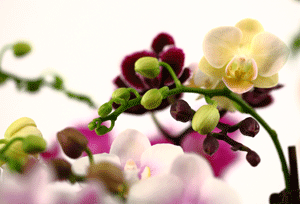 A Phalaenopsis orchid’s flower spike, buds, and blooms are excellent indicators of the plant’s general health. Changes in the normal development or appearance of your orchid often indicate an environmental problem (light, water, humidity or temperature) but may be signs of a pest infestation or disease. Learning to recognize and treat orchid problems can help ensure the longevity and beauty of your orchid.
A Phalaenopsis orchid’s flower spike, buds, and blooms are excellent indicators of the plant’s general health. Changes in the normal development or appearance of your orchid often indicate an environmental problem (light, water, humidity or temperature) but may be signs of a pest infestation or disease. Learning to recognize and treat orchid problems can help ensure the longevity and beauty of your orchid.
Use this guide to recognize and treat orchid problems:
- A discolored or crooked flower spike is usually the sign of a virus. Isolate the plant. You can try repotting, but there’s not much you can do about a virus but wait it out.
- Limp flower spikes indicate that your orchid is not getting enough light. Move the plant closer to the window.
- Short flower spikes indicate too much light. Move the orchid away from the window.
- Spikes that develop a brown tip have been subjected to water that is too cold. Trim off the damaged tissue and bring fertilizer and water to room temperature before using.
- Thin flower spikes can indicate lack of light or phosphorous deficiency. Move the plant closer to the light and apply a high-phosphorous fertilizer.
- Spotted or rotting buds or blossoms are generally caused by fungal growth [http://justaddiceorchids.com/diseases] resulting from excess humidity or moisture on the petals. Trim off damaged flowers and relocate the orchid to a less humid location. Avoid splashing flower petals when watering or fertilizing and perform these tasks early in the day so petals have time to dry.
For more information about orchid flower and bud loss, visit our online orchid care library.
 A Phalaenopsis orchid’s flower spike, buds, and blooms are excellent indicators of the plant’s general health. Changes in the normal development or appearance of your orchid often indicate an environmental problem (light, water, humidity or temperature) but may be signs of a pest infestation or disease. Learning to recognize and treat orchid problems can help ensure the longevity and beauty of your orchid.
A Phalaenopsis orchid’s flower spike, buds, and blooms are excellent indicators of the plant’s general health. Changes in the normal development or appearance of your orchid often indicate an environmental problem (light, water, humidity or temperature) but may be signs of a pest infestation or disease. Learning to recognize and treat orchid problems can help ensure the longevity and beauty of your orchid. 